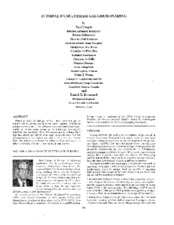| dc.contributor.other | International Pump Users Symposium (13th : 1996) | |
| dc.creator | Cooper, Paul | |
| dc.creator | Schiavello, Bruno | |
| dc.creator | Salis, Jacques de | |
| dc.creator | Marolles, Charles D. | |
| dc.creator | Prang, Allan J. | |
| dc.creator | Broussard, Dan | |
| dc.date.accessioned | 2017-10-05T17:00:37Z | |
| dc.date.available | 2017-10-05T17:00:37Z | |
| dc.date.issued | 1996 | |
| dc.identifier.uri | https://hdl.handle.net/1969.1/164155 | |
| dc.description | Tutorial | en |
| dc.description | pg. 159 | en |
| dc.description.abstract | Pumping crude oil and gas without prior separation greatly reduces the machinery and platform space required. Multiphase pumps can be located at the surface or subsea and are designed primarily as a) two-screw rotary or b) multistage rotordynamic machines that can ingest 90 to 100 percent gas by volume. Each type has advantages and disadvantages, as can be seen from the growing body of test experience, both in the laboratory and the field. Six authors contributed the following five sections, in an effort to provide all facets of the subject in one tutorial. | en |
| dc.format.medium | Electronic | en |
| dc.format.mimetype | application/pdf | |
| dc.language.iso | en | |
| dc.publisher | Texas A&M University. Turbomachinery Laboratories | |
| dc.relation.ispartof | Proceedings of the 13th International Pump Users Symposium | en |
| dc.subject.lcsh | Pumping machinery | en |
| dc.title | Multiphase Gas-Liquid Pumping | en |
| dc.type.genre | Presentation | en |
| dc.type.material | Text | en |
| dc.identifier.doi | https://doi.org/10.21423/R11X18 | |


